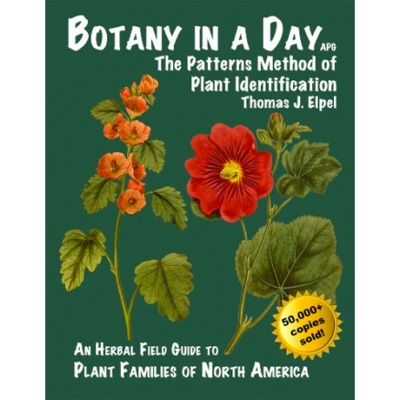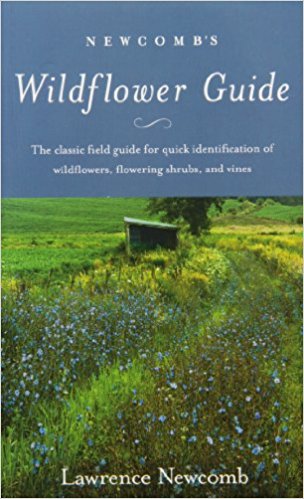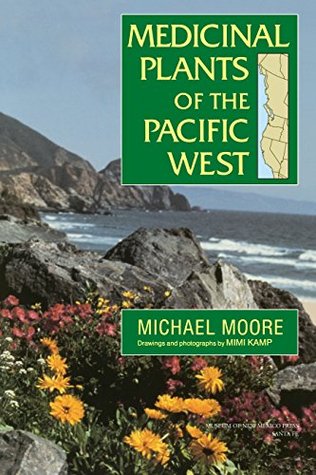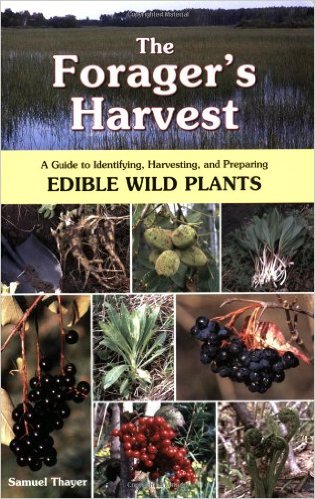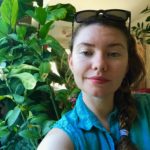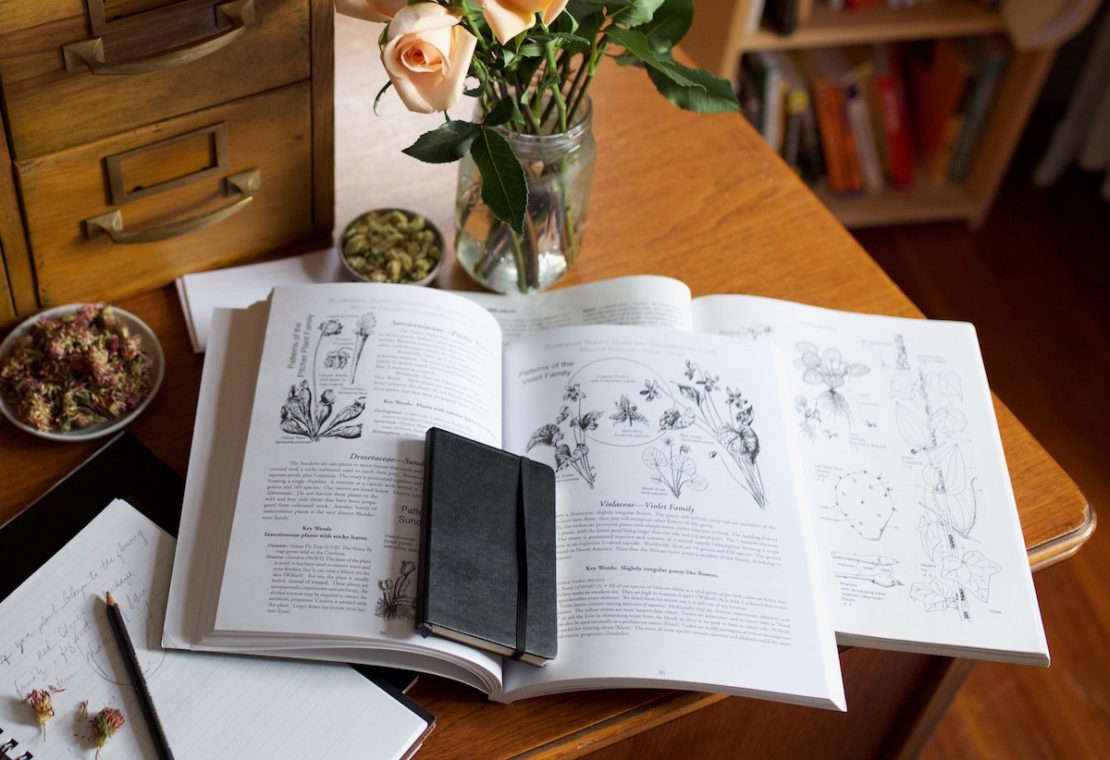
5 Foraging Guide Books To Help You Identify & Harvest Plants
I will always remember the first time someone pointed out plantain to me. I had been hiking with a friend who had studied herbalism, and after she mentioned plantain a few times, I finally asked if she was talking about the banana plant.
After showing me the familiar curbstone sprout and explaining its uses and benefits, my sense of the plant world cracked open a little. This “weed” that I had often absentmindedly pulled up and stripped of its seeds on school field trips was actually packed with health benefits! I began noticing plantain everywhere, defiantly cracking out of the sides of buildings, decorating the sidewalks next to every parking spot, and across any stretch of grass. I wondered what other plants in my neighborhood had therapeutic values I didn’t know about? I soon found myself distracted while running errands, stooping over chain link fences and noting leaf shapes and flower petal patterns of common plants that I often parked my car next to. All of a sudden, every plant I had grown up weeding became relevant and mysterious—prompting me to know it.
This is the power of plant identification and the magic of foraging in your own environment. The fabric of our common environments deepen with plant benefits and lore. New questions arise, like who decided to denigrate them to weeds anyway? Did generations of people in various regions understand the value under their feet? When did they stop knowing and sharing these secrets?
For people at all levels of foraging, cooking, and wildcrafting, a reliable plant identification guide is an indispensable tool in reintroducing ourselves to the plant world. The guides below introduce a few main approaches: encyclopedic monographs to flip through on-the-go, more in-depth plant profiling geared toward herbalism, and foundational techniques for plant identification. Although the most reliable and conveniently-sized may be favored, a combination of approaches will aid in creating a versatile perspective to keep in your back pocket.
5 Foraging Guide Books
1. Botany in A Day – Thomas J. Elpel
Botany in a Day is an indispensable tool for teaching yourself some valuable techniques of plant identification. Thomas J. Elpel accumulated his intuitive ability to identify plants starting at a young age while learning to collect herbs with his grandmother, and he later wrote this book when formally learning botany. This makes it feel a bit like peering into the notebook of an A-student—posing and answering questions that many botany beginners may be familiar with.
His approach emphasizes the value of developing a gut instinct about plants based on integrating a selection of key characteristics to look out for. To help with this, he combines mnemonics, wordplay, and easily answered questions such as: How many petals does it have? Are the leaves alternating or opposite? Are the leaf veins parallel or branching out in a net pattern? With time and practice, these features stand out to the observer and make filtering down to the correct plant family much more immediate. This is useful purely for identification, as well as avoiding potentially dangerous plants based on relatives within their family. Flowers with compound umbels should be identified carefully, for example, because they are from the parsley family which includes relatives such as poison hemlock.
Taking some time with this book before going out in the wild or studying other botanical books will greatly inform and simplify the sometimes dense botanical terminology that can go over one’s head. This book is certainly a valuable first step in learning plant identification that will continually aids one’s development as a forager or herbalist.
2. Newcomb’s Wildflower Guide – Lawrence Newcomb
Lawrence Newcomb’s, Newcomb’s Wildflower Guide has been used for years simply because it provides such an easy template of identification. Similar to Elpel’s approach in Botany in a Day, the student works with a query system to identify shape and structure of unknown flowering plants. This creates a process of elimination that leads the student to a specific page in the book with the corresponding plant. Over time this identification becomes second nature, and the process becomes more quick and intuitive. This book is a handy pocket size which makes it easy to take with you on a hike and even includes a ruler on a page to measure with. It begins with a helpful introduction to plant physiology with detailed line drawings illustrating the characteristics discussed. With only some inclusion of technical and botanical terms this book is approachable for the amateur and informs the streamlines the process of the astute. Although there are no photos, it does include some color illustrations and has an overall refreshing layout for those used to more scientific botanical texts. The significant downside is that this useful approach is only available for the Central and Northeastern regions of the U.S., but learning this process is still valuable to anyone interested in teaching themselves plant identification foundations.
3. Medicinal Plants of the Pacific West – Michael Moore
In this guide, you get a two-for-one deal, a simultaneous foraging guide and materia medica. This book is not only an excellent and in-depth set of monographs from a region that has been woefully underrepresented, but you can inherit the wisdom and philosophy of beloved herbalist Michael Moore as well. His authoritative and often humorous voice emphasizes quality of personal experience over sheer quantity of technical information, and the value of getting to know just a handful of 10-15 plants reminds us that curanderos only ever call upon a handful of favorite plant allies. He encourages finding these for yourself, before attempting to use bulk supply or herbal supplements in order to avoid inconsistent quality or the dubious commercial practices behind them.
This book includes an introduction replete with pearls of herbalist wisdom. It is predominantly made up of monographs with in-depth profiles and detailed black and white illustrations, as well as corresponding color photo plates in the beginning and some helpful indices at the end. Each profile includes common names, botanical names, a thumbnail map of the plant’s region, appearance, habitat, constituents, collection and preparation information, stability, therapeutic uses, and contraindications. Descriptions and language are aimed at the general public and tend to avoid botanical terminology unless necessary. He demonstrates consistent integrity in his decision to only include plants whose populations are strong enough to be foraged and in his discouragement of over-harvesting. His heartening respect for the traditions of native plant healers is reflected in his choosing the names most commonly used in their respective regions, often using native terminology or the Spanish language of curanderos. A warm and welcoming departure from the sometimes dry, scientific blurbs in standard guides, his guidebooks are truly tailored for herbalist considerations and often read like the guiding voice of a wise and witty grandfather, encouraging you to do right, while still having fun.
4. Forager’s Harvest – Samuel Thayer
This is another somewhat tailored list of plant profiles with an experienced author behind it, favoring depth over breadth of information and championing personal experience. Focusing primarily on the Northern Midwest and Northeastern regions, this is a good counterpoint to Michael Moore’s guides of the West. Thayer too has a wealth of knowledge to share and does so, though a bit rambling at times. Even so, there is useful information in every inch of this book that can come in handy at unexpected times.
Aiming to provide the guide that he wanted but couldn’t find, Thayer answers common questions herbalists may have when foraging, including color photos of plants at various angles and stages of development and including optimum harvesting stage. He also has side by side photos of plants often confused for one another to aid certainty in identification. Avoiding commonly regurgitated misinformation, his profiles include standard names and information as well as personal anecdotes of his tried and true experience with these plants. Botanists, herbalists, and amateur foragers alike rank this as one of the most useful and thoughtful guide books, successfully covering all bases and providing resources for recurring questions in the field. This and his other guide, Nature’s Garden have a similar format and are good companions to each other, picking up where the other leaves off without overlap.
5. Peterson’s Field Guide(s)*
Eastern & Central Medicinal Plants and Herbs – Steven Foster & James A. Duke
In the tradition of Roger Tory Peterson’s original field guides, economic botanist James A. Duke and celebrated plant photographer Steven Foster team up to create this handy, though somewhat hefty, pocket sized guide. In a unique, color-coded format, the book is arranged to identify plants by most observable categories, predominantly of flowers by color, as well as trees, shrubs, woody vines and grass-like plants. The color codes are marked in tabs at the bottom of the page to easily flip to a yellow flower, for example, which would then be subdivided into features such as 5-petaled or compound and so on. Though organized differently than taxonomic style guides, it provides an encyclopedic quantity of information that some may crave when out and searching for an unknown plant. If you are passively educating yourself at home, the plant and medical topics indices are the easiest way to navigate and look up imagery of plants of interest. This is a mainly scientific voice but has a hint of personality here and there, evidenced in the safety notes of the Cannabis profile, explaining that the shifting legality of the plant in various locations is its biggest safety concern. If you do best with a scientific, encyclopedic format, this book is a valuable stand by, easy to toss in a backpack and reference when out on a plant walk or to visualize plants you may be studying at home.
*Peterson guides are available in the same format as above, for other regions of North America, with various authors and photography by Steven Foster.
How I Use These Books
Despite the steadily mounting stack of books taking over my living room, I find that each of these guides has a place, and luckily, not all of them are in my backpack. They all seem to inform one another, but some books make the most sense to consume slowly, at home, while others are the best to pack for a day out in the wild.
The default book that does live in my backpack is the Peterson’s Field Guide. Having an encyclopedic list of plants with color photographs to leaf through is the most immediately helpful when you come across an unknown plant of interest. As a newcomer to the field, I wanted to start by looking up everything I came across so this guide is the perfect tool for the job. The color coding helps if the plant is flowering or has an obvious structure to look up, but having taught myself techniques from Newcomb’s Wildflower Guide and Botany in a Day really jump-started my search, highlighting a few more educated guesses to look up, instead of just leafing through indefinitely. Walking through nature with a few of these identifying techniques down pat feels like finally learning the language while traveling in a foreign country. Unreadable signs and symbols previously glossed-over suddenly stand out and make themselves known. Narrowing down a plant’s family this way makes identifying it a much quicker and simpler process.
Once identified, I find going through books in Michael Moore’s and Samuel Thayer’s style to provide valuable advice, tips, and history that expand the profile of each plant with the perspective of a mentor in herbalism, not just botany. Due to the depth of each profile, their catalogues are comparatively thinner than the traditional field guides, so you might not find every plant you come across, and thus, they might not be the guide you need to have on you at all times. However, if you’re planning on going to a habitat of a specific plant included in their books, having it on hand will deepen your experience of finding and harvesting them from the wild.
I’ve found that these styles contain, most importantly, a depth of information on herbalist practice and philosophy interlaced throughout that greatly informed my approach to the entire process. Overall, each style has a benefit and a strength that greatly supplements the strengths of another. So, I keep my stack and a notebook close at hand when studying each new plant.
Looking for more books to support your herbal studies? Our new Herbal Bookshelf can help! Search, preview, and purchase books that have been hand-picked by Herbal Academy educators with ease. What will you add to your herbal library next?
Error, group does not exist! Check your syntax! (ID: 5)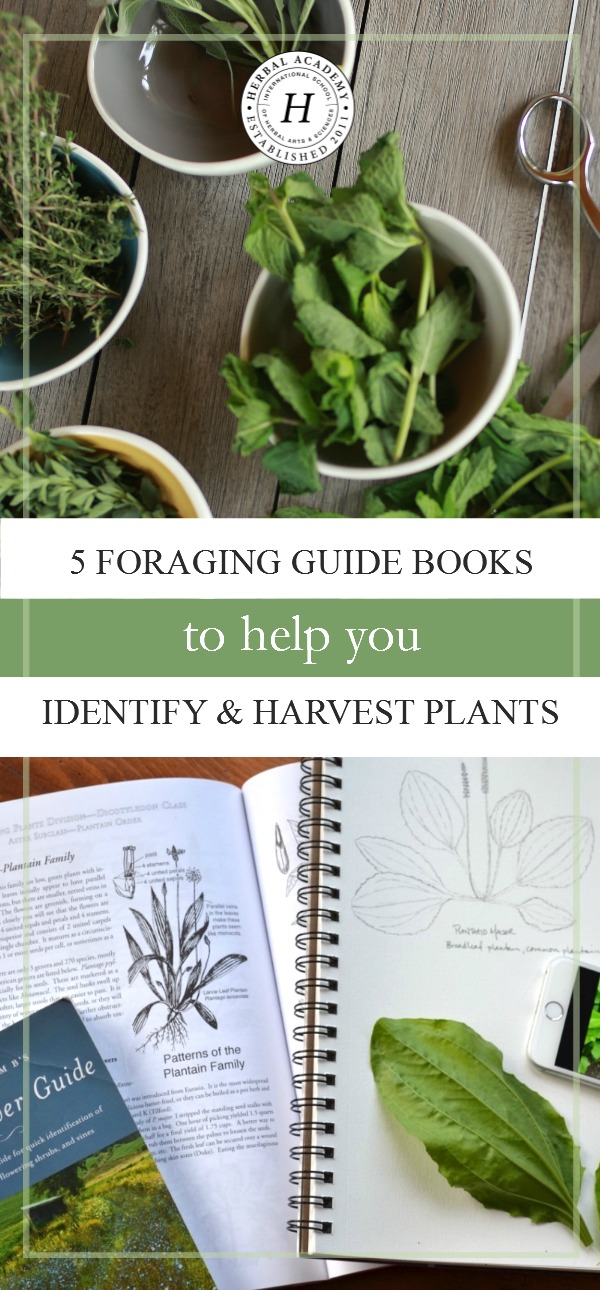
Books and resources listed in the Herbal Bookshelf, as well as in references, citations, and book reviews on the Herbal Academy website may contain titles and language that include words and phrases such as “healing,” “treat,” and “medicinal.” Herbal Academy web pages that include book reviews, products, references, citations, periodicals, or other publications and links should not be construed as medical claim, diagnosis, or treatment. The Herbal Academy is not responsible for the content of these outside resources. The Herbal Academy makes neither medical claim, nor intends to diagnose or treat medical conditions.

